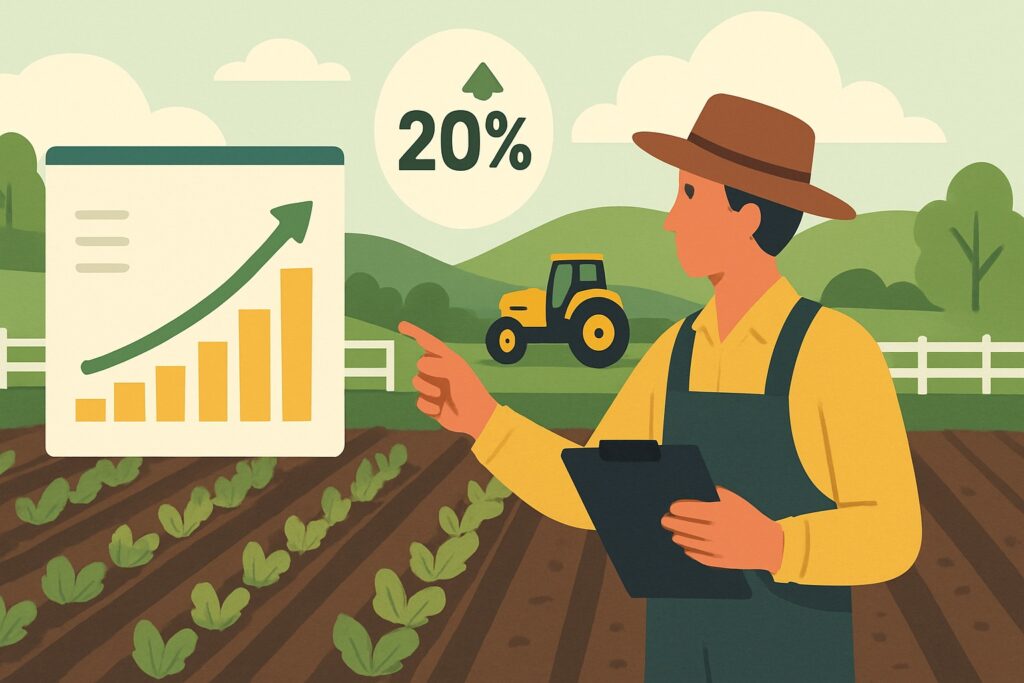Rethink Yield: It’s Not About More Land, It’s About Smarter Farming
The obvious solution to boost crop yield is frequently thought to be more land. The better question, though, is how to increase growth with what you already have in a world where land is scarce, climate change is a concern, and input costs are on the rise.
With the correct data, timing, soil health, and input precision, raising yield by 20% without increasing land is not an impossible goal. Small, calculated adjustments to management techniques by farmers can result in unexpected benefits. The secret is not to put in more effort. It’s to work more strategically, more intelligently, and with a better knowledge of what your land actually requires.
Intelligent intervention holds the key to increased output, from optimising planting patterns to fine-tuning nutrient delivery.
Start With the Soil: The True Engine of Yield
There is no amount of fertiliser, water, or sunlight that can make up for poor soil performance. As a result, the most effective method for increasing yield begins underground.
To determine the pH, texture, nutrient levels, and organic matter content of your soil, do a thorough soil test. Many producers find that their land is either badly lacking in certain locations or oversupplied in others. Sometimes within a single season, balancing these disparities can lead to quantifiable yield increases.
Even minor increases in organic matter can have major effects. According to the Soil Science Society of America, a 1% rise in organic matter improves water-holding capacity by up to 25,000 gallons per acre.
Then concentrate on increasing microbial life. To create a flourishing subterranean environment, use natural stimulants, compost, or cover crops. Disease prevention, root growth, and nutrient cycling are all enhanced by a healthy microbiota.
Now is the time to purchase the best fertiliser online from vendors who provide precisely blended blends for those who apply nutrients based on guesswork from the previous season. Custom fertiliser that is tailored to the unique characteristics of your soil can increase productivity and reduce waste, providing crops with the precise nutrients they require at the right time.
Plant Density and Spacing: Small Adjustments, Big Results
The yield is directly impacted by the spacing of your crops. While too much space wastes potential production per square metre, too close planting creates competition for nutrients and light. Although the optimal density varies depending on the crop and climate, you may optimise your layout by using historical yield maps and plant population calculators.
In one Iowa State University experiment, average yields increased by 8% when the corn plant population was adjusted by only 5% depending on field variability. You’re already halfway to your 20% goal when you multiply it by the number of acres.
Modern precision planters can vary seed spacing on the go, adapting in real time to changes in soil quality. But even with manual tools, strategic adjustments in spacing patterns can help you use every inch of your field effectively.
“High yield is not just the result of more inputs, it’s the reward for giving plants exactly what they need, exactly when they need it.”
Reduce Compaction, Increase Root Reach
Soil compaction restricts root development, water infiltration, and oxygen flow. In compacted soils, plants struggle to access deeper nutrient layers, limiting their size and productivity.
To counteract compaction:
- Use controlled traffic farming or permanent bed systems
- Reduce unnecessary tillage
- Incorporate deep-rooted cover crops like radish or sunflower
Addressing compaction often leads to immediate visual differences in crop performance, especially after a rainfall. Roots grow longer, nutrient uptake improves, and water drainage increases—factors that all contribute directly to yield.
Leverage Data and Tech Tools
You don’t need expensive equipment to use technology effectively. Simple apps and handheld tools can provide insights into soil moisture, nutrient levels, plant health, and disease risk. The key is not having more data, but having useful data.
Platforms like FieldView allow farmers to analyze yield maps, track input performance, and test small-scale changes. Even drone imagery or mobile-based scouting apps can show where fields are underperforming.
Spotting these zones lets you intervene early—whether that means adding compost, adjusting irrigation, or changing seed variety. It’s precision farming without the huge overhead.
Must Read: How Virucides Can Enhance Crop Yield and Quality
FAQs
- Can I really get 20% more yield without more inputs?
Yes, if you optimize what you already use. Improving timing, placement, soil health, and crop selection often outperforms simply increasing input volume. - What if my land is already producing well?
Even high-yield land usually has room for micro-improvements. Marginal gains across several areas can add up to a major jump. - Does this require expensive tech?
Not necessarily. Many improvements can be made through observation, planning, and small investments in soil testing or targeted inputs. - Will organic methods work too?
Absolutely. Organic farms also benefit from improved rotation, compost, biologicals, and strategic planting. The principles are the same. - How fast can I see results?
Some results show up within weeks, especially with microbial applications or better nutrient timing. Others, like improved organic matter, take a full season or more.

